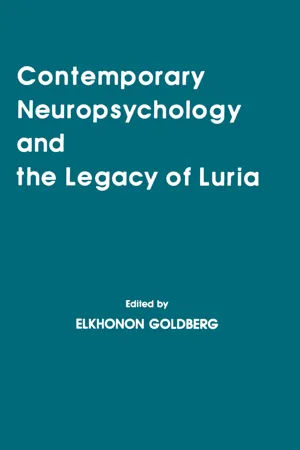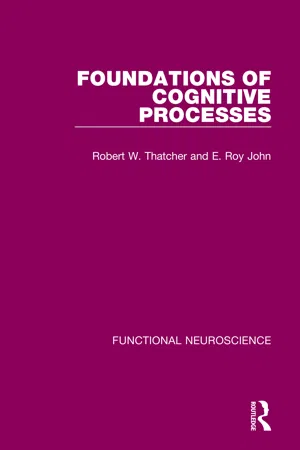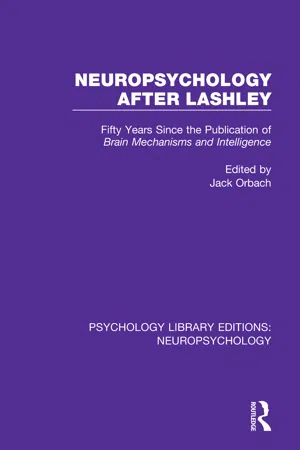Psychology
Localisation of Function in the Brain
The concept of localisation of function in the brain refers to the idea that specific mental and physical functions are associated with distinct areas of the brain. This principle suggests that different regions of the brain are responsible for different functions, such as language processing, motor control, and sensory perception. The study of localisation of function has contributed to our understanding of how the brain supports various cognitive and behavioral processes.
Written by Perlego with AI-assistance
Related key terms
Related key terms
1 of 4
Related key terms
1 of 3
7 Key excerpts on "Localisation of Function in the Brain"
- eBook - ePub
Cognitive Science
Contributions to Educational Practice
- Marlin L. Languis, James Buffer, Daniel Martin, Paul Naour(Authors)
- 2012(Publication Date)
- Routledge(Publisher)
Concepts about the relationship between brain and behavior have historically fallen into one of two diametrically opposed perspectives. The “localizers” represented by the tradition of Broca (1861) and others (Penfield & Boldrey, 1937; Benson & Geschwind, 1971) have conceived of behavioral localization as a mosaic of foci in the brain, with each foci representing discretely localized functions. This view was based on clinical-pathological correlations in which an important contribution to normal function is inferred from loss of behavior in pathological states (Wernicke, 1908) as well as the behavioral manifestations following electrical stimulation of intact tissue (Penfield & Boldrey). This idea of behavior as distributed in a “map” or “mosaic” fashion across the cortex has been a very powerful concept and has led to a basic understanding of the organization of language and motor-sensory function.The second concept of behavioral localization, termed “mass action”, was promoted by Lashley (1929). This concept emphasizes the behavioral importance of the amount of brain tissue lost. That is, the behavioral manifestations depend less on where tissue is lost in the brain than on how much tissue is lost. Chapman and Wolfe (1959) demonstrated that the deficits in cognition following neurosurgery correlated with the amount rather than the specific locus of brain tissue surgically removed. This is a powerful concept in brain injury that explains such clinical phenomena as the recovery from behavioral symptoms. In addition, this theory of mass action is more consistent with what we know about behavioral plasticity in the brain and recovery of function than the strict localizationist theory.Neither of these theories, however, has been able to explain the relationship between brain injury and emotional state. Localization of MoodNumerous investigators have studied relative hemispheric involvement in mood using brain-injured patients, intracarotid amytal injections, or unilateral visual or auditory input in nonbrain-injured volunteers. In a previous publication, we extensively reviewed this literature (Pearlson & Robinson, 1981). In general, these studies have commonly reported right-left hemisphere asymmetries in the production or expression of mood. For example, Gainotti (1972, 1979) has reported that right hemisphere brain injury is associated with indifference and a tendency to joke and minimize difficulties. Amytal studies have generally reported depressive reactions associated with left hemisphere inactivation and euphoria associated with right hemisphere inactivation (Terzian, 1964; Rossi & Rosandini, 1967). Likewise, tachistoscopic unilateral visual field stimulation and dichotic listening studies have reported negative emotion associated with right hemispheric stimulation and positive emotion following left hemisphere stimulation (Dimond, Farrington, & Johnson, 1976; Safer & Leventhal, 1977). Although there are numerous theories ranging from differential activation in the two hemispheres to each hemisphere producing a different mood (Tucker, 1981; Sackheim et al. - Elkhonon Goldberg(Author)
- 2019(Publication Date)
- Psychology Press(Publisher)
It is noteworthy that formulations of functional localization within the brain, as well as the opposing view of the brain as a diffusely organized equipotential structure, were mainly concerned with spatial issues. At no time during the 19th, or the first half of the 20th century did concepts of functional localization within the brain intersect with Donders's idea of mental chronometry. The virtual absence of temporal factors in neuropsychological theories is remarkable. Almost alone, von Monakov (1911) called attention to the "chronological localization of function" within the brain. But as with Donders, neither the conceptual atmosphere nor the necessary physiological techniques were available to support empirical studies of the temporal aspects of brain function.Some neuropsychological formulations appear to equate the localized processing carried out within a particular cortical structure with a processing stage, for example, visual word recognition. However, Luria (1973) pointed out that psychological processes should not be considered the function of a circumscribed tissue, but rather of an extended system, each part of which carries out various aspects of the process under consideration. This formulation clearly implies a temporal sequence of brain activation, in which a number of more or less localized brain areas carry out specific operations that are linked dynamically within the overall psychological process. If methods were available to observe the moment-to-moment activity within the brain, these dynamic patterns of local activation could be visualized. Indeed, evidence obtained by modern techniques for measuring local metabolic changes associated with neural activity, such as regional blood flow and positron emission tomography, have conclusively demonstrated the correctness of cortical localization, not only of sensorimotor processes, but of complex linguistic and cognitive activity (e.g., Lassen, Roland, Larsen, Melued. & Soh, 1977; Mazziota, Phelps, Carson, & Kuhl, 1982). Thus, during speech or reading, for example, multiple cortical areas increase their metabolic activity in the course of these mental and behavioral processes. The location of these circumscribed regions conforms quite well with the conventional cortical localization schemata derived from clinical observations on the impact of focal brain lesions.- eBook - ePub
- Robert W. Thatcher, E. Roy John(Authors)
- 2021(Publication Date)
- Routledge(Publisher)
in the dark between the operations, loss of visual function occurs just as though a one-stage bilateral lesion had been inflicted. Also, animals who were exposed for several hours each day to diffuse, unpatterned visual stimulation or who were passively transported through a patterned visual environment for the same period each day between the successive operations failed to retain previously acquired pattern discriminations and could not be retrained on such tasks. However, animals permitted self-produced locomotion in the same patterned environment for several hours each day during the interval between operations showed complete sparing of the pattern discrimination or very rapid reacquisition (Dru, Walker, & Walker, 1975).VII. A Note of Caution
Such findings establish that the localization of function within any area of the brain must be evaluated with great caution, even when apparent physiological correlates of function have been demonstrated in as great detail as has been the case with the elegant studies of “feature extractor” cells of the visual cortex. It should go without saying, but we will nonetheless state for the record, that similar caution must be exercised with respect to our own arguments in this Volume against localization. We voice a strong warning against overenthusiastic proponents of either position, localizationist or antilocalization, who ignore or shrug off the contraditions. It is precisely from the reconciliation of the apparent contradictions that we stand to learn most about how the brain processes information.Yet it seems to us that for at least several decades an overly strong doctrine of localization of function has dominated our thinking. Adherents to this doctrine have strongly influenced the practice of neurology, neurosurgery, and rehabilitation medicine, and have played a critical role in remedial training and education of the handicapped either directly or through the construction of physiological models of sensation, learning, and memory which depend upon specific neuronal pathways connecting neurons or regions mediating specific functions. As a result of the unquestioning acceptance of this doctrine, many individuals showing effects of congenital, traumatic, or surgical brain damage have been regarded as irreversibly handicapped. Localization of function may indeed be more discreet in human beings than in lower mammals, as some workers contend. Yet enough cases exist of striking recovery after loss of brain tissue due to cerebrovascular accident, traumatic injury, disease, or neurological intervention, together with a huge body of experimental data from lower animals which have simply not been exhaustively examined for their possible relevance to human rehabilitation, to make it plausible that a substantial number of functional deficits now considered irreversible in humans could be treated with substantial or complete functional restoration. - Steven Laureys(Author)
- 2006(Publication Date)
- Elsevier Science(Publisher)
The basic assumption is that neuronal activity is increased in a functionally specialized area during the execution of a task that employs that specialization. Locations of active areas, cluster sizes, and dynamical properties of the signal can be compared across cognitive conditions. Tasks are designed to either include or exclude the cognitive component of interest, and the signals elicited from these tasks are compared (Price et al., 1997). Neural systems and cognitive processes Although differentiation of brain areas by functional specificity is a well-established principle of cortical organization, recent approaches to study human cognition have focused on the integration of groups of specialized areas into long-range units that collectively serve as the comprehensive neural substrate for specific cognitive tasks. According to Mesulam (1998) : “A central feature in the organization of the large-scale network is the absence of one-to-one correspondences among anatomical sites, neural computations and complex behaviors.” Thus, an individual cognitive or behavioral domain is subserved by several interconnected sites, leading to a distributed neural system with functional specificity. An early empirical foundation for this emerging view is found in the work of Mishkin and Ungerleider (1982), who described ventral and dorsal pathway segmentation during visual tasks that required either object identification or object localization, respectively. More recently, direct interactions between multiple brain regions that participate in a variety of complex functions and behaviors have been proposed as evidence for this systems model. For example, covariations between BOLD responses in separate cortical areas during complex attention tasks (Buchel and Friston, 1997) have been described using a statistical approach called structural equation modeling to determine whether the covariances between areas are due to direct or indirect interactions- eBook - ePub
- Michael Cole(Author)
- 2017(Publication Date)
- Routledge(Publisher)
Vygotsky's ideas radically altered our view of the nature and structure of mental processes. Fixed and immutable "mental functions" were transformed into complex and mobile functional systems that change during development; psychology emerged from its constricting naturalistic boundaries and became the science of the social formation of natural phenomena.One question, however – perhaps the most essential one –remained open: How is the material substratum to be understood? What conceptions of the working of the brain should underlie our view of the material bases of mental activity?The problem of localizing mental functions in the cerebral hemispheres (and the question of the cerebral bases of mental activity was formulated in precisely this way) underwent a period of acute crisis in the 1920s, reflecting to a large extent the general crisis in psychology. On the one hand, neurology continued to assert its naive ideas of the localization of complex mental functions in limited areas of the cerebral cortex – ideas originally crystallized in the great discoveries of the 1870s. On the basis of the simplified views of mental functions then current in psychology, neurologists assumed that in addition to the cortical sensory and motor "centers," analogous centers could be found for more complex mental processes. As a result of the writings of Lissauer, Henschen, and Kleist, the idea of "perceptual centers," "calculational centers," and "conceptual centers" in the cerebral cortex did not seem the least bit extraordinary.Naturally enough, however, these views of restricted localization gave rise to serious doubt. Aware of the complexity of human higher mental processes and taking into account the well-known clinical fact that they could be disrupted by injuries in widely varied locations, many neurologists assumed that complex forms of mental processes were the result of the activity of the brain as a whole. Some of these authors, adhering to the holistic viewpoint (Monakov, Grunbaum), under the noticeable influence of the Würzburg school of psychology, were indifferent to all attempts to examine more closely the cerebral apparatuses connected with higher forms of mental activity. Others, supporting Gestalt psychology (K. Goldstein), tried to construct a hypothesis of an excitation structure evenly distributed throughout the cortex and to see the basis of complex forms of human mental activity in these featureless "structural" processes. While accepting a restricted localization of elementary physiological processes in limited areas of the cortex, they rejected in practice all concrete analysis of the critical zones that take part in the execution of complex forms of human mental activity. "Revolving in a vicious circle of structural psychology," wrote Vygotsky, "examination of the localization of specifically human functions vacillates between the poles of extreme naturalism and extreme spiritualism" (loc. cit. P. 386). - eBook - ePub
Neuropsychology After Lashley
Fifty Years Since the Publication of Brain Mechanisms and Intelligence
- Jack Orbach(Author)
- 2018(Publication Date)
- Routledge(Publisher)
13 Localization and Distribution of Function in the Brain Karl H. Pribram Departments of Psychiatry and Psychology Stanford University School of MedicineIntroduction
Throughout his research career, Karl Lashley remained puzzled by the relationship between brain, behavior, and experience. On one hand, his experiments showed the brain to be put together with exquisite anatomical precision, which was to some degree reflected in the separation by behavioral function of the several sensorimotor systems and even regional differences within the so-called association areas. On the other hand, results of other experiments and observations made it clear that engrams, memory traces, could not be localized and that perceptual images and motor patterns displayed constancies and equivalences for which it was difficult to conceive any permanent “wiring diagram.” Lashley is best known for his continuing attention to these nonlocalizable aspects of brain function that he formalized in the laws of mass action and equipotentiality. But it should be remembered that these aspects were puzzling to Lashley in large part because he was so keenly aware of the anatomical precision of the connectivity that gave rise to nonlocal characteristics in function. Had the brain been shown to be essentially a randomly connected network (as was so often assumed by those then working in the field of artificial intelligence), the problem might not have loomed so insurmountable.In this chapter I present data that fill out a theoretical frame that was proposed by Lashley as a possible resolution of the localization/nonlocalization puzzle. These data have accumulated during the quarter century that has intervened since his last paper. The data have been gathered without reference to the frame, and the frame itself was derived, not from brain-behavior studies, but from the problems posed by morphogenesis during embryological development: Structural theories based on the principle of chemical gradients and resonances that “tune” specific locations in cytoplasm as inductors for organelles have been influential in embryology since before the turn of the century (see, e.g., Jacques Loeb, 1907; and Paul Weiss, 1939). In 1906, Goldscheider suggested that the structures of perception and memory might be similarly constructed by resonances among wave fronts created by sensory inputs in brain, especially cortical, tissue. In 1942, Lashley adopted this view as an alternative both to Köhler’s field theory and to a localizationist view in which one percept or engram is matched to one neuron or neuron assembly. Lashley was never satisfied with this adoption because he could not envision the specific mechanisms that would give rise to resonant (and interfering) wave fronts in brain tissue and, equally important, how these, in turn, might be responsible for the structures that comprise perception and engram. He nonetheless held to the view that neither field nor localization (as, e.g., in the sophisticated development of Hebb, 1949) could account for the complex relationship between brain anatomy and phenomenal experience or could deal adequately with the encoding of memory. - eBook - ePub
Connectionist Psychology
A Textbook with Readings
- Rob Ellis, G.W. Humphreys(Authors)
- 2020(Publication Date)
- Psychology Press(Publisher)
Abstract : When cognitive neuropsychologists make inferences about the functional architecture of the normal mind from selective cognitive impairments they generally assume that the effects of brain damage are local, that is, that the nondamaged components of the architecture continue to function as they did before the damage. This assumption follows from the view that the components of the functional architecture are modular, in the sense of being informationally encapsulated. In this target article it is argued that this “locality” assumption is probably not correct in general. Inferences about the functional architecture can nevertheless be made from neuropsychological data with an alternative set of assumptions, according to which human information processing is graded, distributed, and interactive. These claims are supported by three examples of neuropsychological dissociations and a comparison of the inferences obtained from these impairments with and without the locality assumptions. The three dissociations are: selective impairments in knowledge of living things, disengagment of visual attention, and overt face recognition. In all three cases, the neuropsychological phenomena lead to more plausible inferences about the normal functional architecture when the locality assumption is abandoned. Also discussed are the relations between the locality assumption in neuropsychology and broader issues, including Fodor’s modularity hypothesis and the choice between top-down and bottom-up research approaches.Keywords : brain lesions, cognitive architecture, face recognition, localization, modularity, neural nets, neuropsychology, semantics, visionThe fact that the various parts of the en-cephalon, though anatomically distinct, are yet so intimately combined and related as to form a complex whole, makes it natural to suppose that lesions of greater or lesser extent in any one part should produce such general perturbation of the functions of the organ as a whole as to render it at least highly difficult to trace any uncomplicated connection between the symptoms produced and the lesion as such. Ferner (1886) .1. Introduction
Brain damage often has rather selective effects on cognitive functioning, impairing some abilities while sparing others. Psychologists interested in describing the “functional architecture” of the mind, that is, the set of relatively independent information-processing subsystems that underlies human intelligence, have recognized that patterns of cognitive deficit and sparing after brain damage are a potentially useful source of constraints on the functional architecture. In this target article I wish to focus on one of the assumptions that frequently underlies the use of neuropsychological data in the development of cognitive theories.
Index pages curate the most relevant extracts from our library of academic textbooks. They’ve been created using an in-house natural language model (NLM), each adding context and meaning to key research topics.
Explore more topic indexes
Explore more topic indexes
1 of 6
Explore more topic indexes
1 of 4






